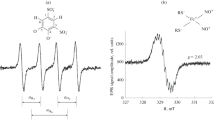Summary
Toxic peroxides result when oxygen radicals with various peroxidic precursors in tissue or blood. A colorimetric method based on reactions of malondialdehyde (MDA), a key intermediate in the formation of peroxides, has been described in fresh tissues. The present report adapts this assay to measure MDA levels in frozen heart muscle from rats and swine. Mean tissue values of MDA ranged from 154–353 nmol/g (n=13) in fresh rat hearts perfused by the Langendorff technique. Values in frozen samples were 228±14 nmol MDA/g (n=22). When mechanical function was increased in isolated working rat hearts, tissue MDA levels decreased by-25‡% (P<0.025). In working swine hearts, increasing perfusate levels of unsaturated fatty acids caused a 42% increase in tissue MDA levels, P<0.001. Suppressing fatty acid oxidation with either oxfenicine or low flow ischemia caused no significant shifts in peroxide contents. Thus, the thiobarbituric acid method for MDA measurements is well adapted to analyzing frozen myocardium, and MDA levels appear sensitive to alterations in mechanical function and the presence of excess fatty acids.
Similar content being viewed by others
References
Caldarera CM, Davalli P, Guarnieri C (1978) Effect of alpha-tocopherol and sodium selenite on post-anoxic reoxygenated rat hearts. J Molec Cell Cardiol 10 (Suppl):16
Dahle LK, Hill EG, Holman RT (1962) The thiobarbituric acid reaction and the autoxidations of polyusaturated fatty acid methyl esters. Arch Biochem Biophys 98:253–261
DelMaestro RF, Thaw HH, Bjork J, Planker M, Arfors KE (1980) Free radicals as mediators of tissue injuring. Acta Physiol Scand Suppl 492:43–58
Dillard CJ, Kunert KJ, Tappel AL (1982) Effects of vitamin E, ascorbic acid and mannitol on alloxan-induced lipid peroxidaton in rats. Arch Biochem Biophys 216:204–212
Fridovich I (1975) Superoxide dismutases. Ann Rev Biochem 44:147–159
Guranieri C, Ferrari R, Visioli O, Caldarera CM, Nayler WG (1978) Effect of alpha-tocopherol on hypoxic perfused and reoxygenated rabbit heart muscle. J Molec Cell Cardiol 10:893–906
Guller B, Yipintsoi T, Orvis AL, Bassingthwaighte JB (1975) Myocardial sodium extraction at varied coronary flows in the dog: Estimation of capillary permeability by residue and outflow detection. Circulation 37:359–378
Gutteridge JMC (1981) Thiobarbituric acid-reactivity following iron-dependent free-radica damage to amino acids and carbohydrates. FEBS Letters 128:343–346
Higgins AJ, Morville M, Burges RA, Blackburn KJ (1981) Mechanism of action of oxfenicine on muscle metabolism. Biochem Biophys Res Comm 100:291–296
Krinsky NI, Scoon KL, Hardin JC, Levine PH (1977) Source of hydrogen peroxide and of chemiluminescence observed in activated human platelet preparations. Blood J Hematol 50:597–602
Liedtke AJ, Nellis SH, Mjos OD, Whitesell L, Mahar C (1982) Effects of inhibiting fatty acids in regionally ischemic hearts. Circulation 66., Suppl II, 332
Liedtke AJ, Nellis SH, Neely JR (1978) Effects of excess free fatty acid on mechanical and metabolic function in normal and ischemic myocardium in swine. Circ Res 43:652–661
Liedtke AJ, Vary TC, Nellis SH, Fult CW (1982) Properties of carnitine incorporation in working swine hearts: Effects of coronary flow, ischemia, and excess fatty acids. Circ Res 50:767–774.
Neely JR, Liebermeister H, Battersby RJ, Morgan HE (1967) Effect of pressure development on oxygen consumption by isolated rat heart. Am J Physiol 212:804–814
Ohkawa H, Ohishi N, Yagi K (1979) Assay for lipid peroxides in animal tissues by thiobarbituric acid reaction. Analyt Biochem 95:351–358
Tanizawa H, Sazuka Y, Takino Y (1981) Micro-determination of lipoperoxide in the mouse myocardium by thiobarbituric acid fluorophotometry. Chem Pharm Bull 29:2910–2914
Weening RS, Wever R, Roos D (1975) Quantitative aspects of the production of superoxide radicals by phagocytizing human granulocytes. J Lab Clin Med 85:245–252
Author information
Authors and Affiliations
Additional information
Funded in part by USPHS Grant HL 21209 and the Rennebohm Foundation
Rights and permissions
About this article
Cite this article
Liedtke, A.J., Mahar, C.Q., Ytrehus, K. et al. Estimates of free-radical production in rat and swine hearts: method and application of measuring malondialdehyde levels in fresh and frozen myocardium. Basic Res Cardiol 79, 513–518 (1984). https://doi.org/10.1007/BF01910480
Received:
Issue Date:
DOI: https://doi.org/10.1007/BF01910480




